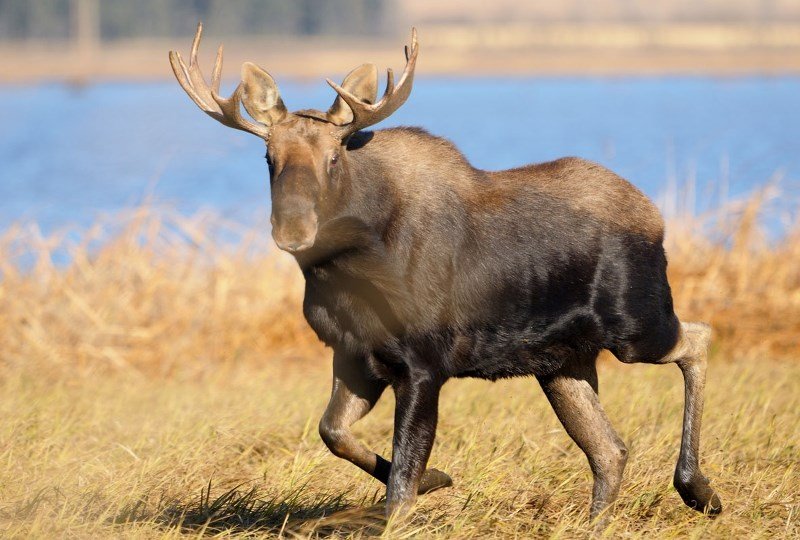New guide on Big Lake mammals, reptiles, and amphibians
Nature fans can now learn all about the moose, mice, and wolverines of Big Lake through a just-released guide to the animals of Lois Hole Park. The Big Lake Environment Support Society’s Animal Guide to Lois Hole Centennial Provincial Park is available for purchase and in a free digital version.
The guide contains photos and information on 53 mammals, reptiles, and amphibians found in and around Lois Hole Park based on local knowledge and scientific research. The guide covers salamanders, toads, frogs, and snakes around Big Lake, said co-author Lyn Druett. These species tend to be elusive, and park visitors were more likely to hear than see them.
Guide co-author Linda Brain said researching the animals of Big Lake left her awestruck. The muskrat has two-to-three litters of six-to-eight young a year and serves as a food source for many predators. Big Lake was also likely home to thirteen-lined ground squirrels, which breathe once every five minutes during hibernation, and pygmy shrews, which eat three times their body weight every day.
Perhaps the most surprising entry in the guide is the wolverine, a ferocious, brown, stocky, dog-like creature that has been spotted just twice around Lois Hole Park in the last 10 years. Purchase and free digital version information at https://www.stalbertgazette.com/local-news/new-guide-for-big-lakes-animals-available-6344515
Three easy to grow flowers and one challenging flower
(Photo by Kristyn Mayner)
Wildflower News has an excellent article which is the first in a series to help people decide which native plants to add to their gardens this year. Three species will be featured each month with the article outlining the advantages and disadvantages of each and their distinctive features. A challenging species has been added for those of you who are looking for a challenge or something new.
Three easy to grow flowers are meadow blazingstar, giant hyssop, and gaillardia. All of these species have seeds that can be planted in spring without any special treatment. All three species attract and feed bees, butterflies, other pollinators and birds. These flowers are all perennials.
Who doesn’t love prairie crocus, the first flower of spring. It often pops up through the snow and their flowers are ready for harsh spring conditions. Each flower is a little solar energy collector that follows the sun. The petals, actually sepals, reflect the sunlight towards the centre, warming it by as much as 10 degrees above the surrounding temperature. However, this beautiful plant is challenging to grow.
Native plants in general bloom in the second year but could bloom in the first or third year in some instances. These plants do well in Edmonton garden soil without a lot added. Some may benefit from a small amount of compost added to soil. They do not need to be watered once they are established unless there is a drought. Learn more at https://cdn.sanity.io/files/d59screl/production/d4058cf2babdd6425c58826de8c81fb787cbfe87.pdf
Nocturnal animals that thrive in the dark
Meghan Jacklin, Conservation Coordinator for the Edmonton and Area Land Trust, recently spoke on CBC Radio about animals that thrive in the dark. Nocturnal animals in Edmonton includes foxes, owls, porcupines, skunks, bats in summer, and our most recent addition, the raccoon.
Being active at night means avoiding competition with animals active in the daytime and helps to avoid predators. Red squirrels are active in the day, while flying squirrels are active at night. Flying squirrels have large eyes to see in the dark and though called flying, actually glide. During the day, they roost in tree cavities.
A good spot to watch nocturnal animals is bird feeders. Flying squirrels will glide to feeders to eat and gather up the seeds and food left there. Porcupines will feast on fruit and seeds lying on the ground. Our river valley with its trees and natural habitat is also a good place to see nocturnal creatures. Remain quiet, lights out, and you may be surprised at the activity around you. Listen to interview at https://www.cbc.ca/listen/live-radio/1-17-edmonton-am/clip/15956255-its-dark-outside-animals
Balsam Poplar can live up to 70 years
Balsam poplar is a fast growing, fast suckering tree that prefers moist to wet sites, and can handle seasonal flooding. Indeed, it is well adapted to flooding: its deep, binding root system is excellent for holding together the banks of rivers, streams, lakes, and wetlands. Further, its infamous white fluff is timed perfectly with the June flood season, sprouting up on the exposed wet soils that are left as the waters recede.
The seeds of balsam poplar are eaten by birds, and the sticky fragrant leaf buds have medicinal properties, and can be used in salves and infused oils. Bees sometimes harvest the resin from balsam poplar and use it to disinfect their hives.
Balsam poplar is an excellent, commonly used pioneering species for Eco-Buffers, and is also used extensively in riparian buffers. It can provide a quick “nurse crop” for shade-tolerant species needing wind protection to get established, such as hemlock or white pine. It is often planted as a fast-growing windbreak in rural areas and does not root sucker as readily as other species.
The range of balsam poplar spans coast to coast and it is one of the hardiest deciduous trees in Canada. More at https://www.awes-ab.ca/species/balsam-poplar/
New Life. . .New Beginnings by Richard Tosczak, Hawrelak Park https://www.edmontonpublicart.ca/#!/details/78
Comment or contribution
Please note that articles may not reflect the position of NSRVCS. River Valley News is meant to be a clearinghouse for the wide variety of opinions and ideas about Edmonton’s River Valley. Email river valley photos, event information, comments, or questions to nsrivervalley@gmail.com
Sincerely yours,
Harvey Voogd
North Saskatchewan River Valley Conservation Society
780.691.1712





